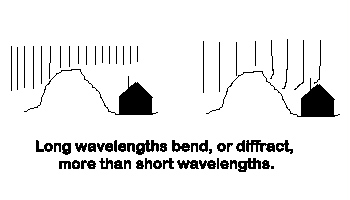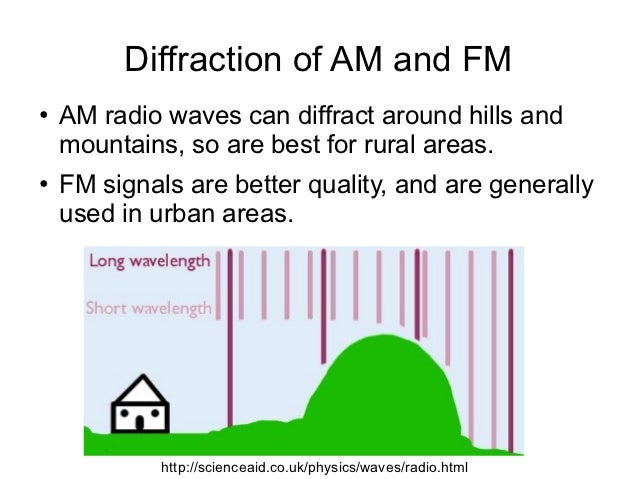Confused about Radio Waves, which can diffract and which can't?
In my CGP guide, it says: "Radio waves used for TV and FM radio transmissions have very short wavelengths (10cm-10m). To get reception, you must be in direct sight of the transmitter - the signal doesn't bend around hills or travel far through buildings."
Whereas, the BBC website says this:"Radio waves are used to transmit television and radio programmes. Television uses higher frequencies than radio.A radio programme receiver does not need to be directly in view of the transmitter to receive programme signals. Diffraction allows low-frequency radio waves to be received behind hills, although repeater stations are often used to improve the quality of the signals."I am so confused; I get that long wavelength waves are diffracted and short wavelengths or not, but these two articles seem to have contrasting statements.The CGP one sasys that for radio and tv you need to be in sight of the transmitter, but the bbc one says that you dont need to be in sight of it for tv and radio.Can someone explain it properly please?
Whereas, the BBC website says this:"Radio waves are used to transmit television and radio programmes. Television uses higher frequencies than radio.A radio programme receiver does not need to be directly in view of the transmitter to receive programme signals. Diffraction allows low-frequency radio waves to be received behind hills, although repeater stations are often used to improve the quality of the signals."I am so confused; I get that long wavelength waves are diffracted and short wavelengths or not, but these two articles seem to have contrasting statements.The CGP one sasys that for radio and tv you need to be in sight of the transmitter, but the bbc one says that you dont need to be in sight of it for tv and radio.Can someone explain it properly please?
Original post by blobbybill
In my CGP guide, it says: "Radio waves used for TV and FM radio transmissions have very short wavelengths (10cm-10m). To get reception, you must be in direct sight of the transmitter - the signal doesn't bend around hills or travel far through buildings."
Whereas, the BBC website says this:"Radio waves are used to transmit television and radio programmes. Television uses higher frequencies than radio.A radio programme receiver does not need to be directly in view of the transmitter to receive programme signals. Diffraction allows low-frequency radio waves to be received behind hills, although repeater stations are often used to improve the quality of the signals."I am so confused; I get that long wavelength waves are diffracted and short wavelengths or not, but these two articles seem to have contrasting statements.The CGP one sasys that for radio and tv you need to be in sight of the transmitter, but the bbc one says that you dont need to be in sight of it for tv and radio.Can someone explain it properly please?
Whereas, the BBC website says this:"Radio waves are used to transmit television and radio programmes. Television uses higher frequencies than radio.A radio programme receiver does not need to be directly in view of the transmitter to receive programme signals. Diffraction allows low-frequency radio waves to be received behind hills, although repeater stations are often used to improve the quality of the signals."I am so confused; I get that long wavelength waves are diffracted and short wavelengths or not, but these two articles seem to have contrasting statements.The CGP one sasys that for radio and tv you need to be in sight of the transmitter, but the bbc one says that you dont need to be in sight of it for tv and radio.Can someone explain it properly please?
some waves diffract less than others

but do the radio/tv waves require you to be inline with the receiver or not? One says you do, one says you dont.
Original post by thefatone
some waves diffract less than others


Original post by blobbybill
but do the radio/tv waves require you to be inline with the receiver or not? One says you do, one says you dont.
i think the diagram answers that, see the(diagram on the right) one with a longer wavelength diffracts more? that doesn't need to be inline with the receiver since it bends round corner and stuff more.
a shorter wavelength however (diagram on the left) diffracts less and can't reach the reciever so the shorter the wavelength, the less if diffracts, the more it needs to be inline with the reciever
Original post by thefatone
i think the diagram answers that, see the(diagram on the right) one with a longer wavelength diffracts more? that doesn't need to be inline with the receiver since it bends round corner and stuff more.
a shorter wavelength however (diagram on the left) diffracts less and can't reach the reciever so the shorter the wavelength, the less if diffracts, the more it needs to be inline with the reciever
a shorter wavelength however (diagram on the left) diffracts less and can't reach the reciever so the shorter the wavelength, the less if diffracts, the more it needs to be inline with the reciever
Yes, and your diagram confirms that. I am asking for with radio waves that are used for TV and FM radio, are they long enough wavelengths to diffract? The CGP says that they are not, whereas the BBC says that they are.
Thanks
Original post by blobbybill
Yes, and your diagram confirms that. I am asking for with radio waves that are used for TV and FM radio, are they long enough wavelengths to diffract? The CGP says that they are not, whereas the BBC says that they are.
Thanks
Thanks

maybe this helps?
It's not a case of this wave diffracts and that wave doesn't... it's that this (AM radio frequency) wave diffracts more than that (TV frequency) wave
typical AM radio frequency 1.152 MHz ~ 261 m wavelength
typical TV frequency 500 Mhz ~ 0.6 m wavelength
The BBC website is probably written for a less technical audience and is therefore less careful about its terms
typical AM radio frequency 1.152 MHz ~ 261 m wavelength
typical TV frequency 500 Mhz ~ 0.6 m wavelength
The BBC website is probably written for a less technical audience and is therefore less careful about its terms
Original post by Joinedup
It's not a case of this wave diffracts and that wave doesn't... it's that this (AM radio frequency) wave diffracts more than that (TV frequency) wave
typical AM radio frequency 1.152 MHz ~ 261 m wavelength
typical TV frequency 500 Mhz ~ 0.6 m wavelength
The BBC website is probably written for a less technical audience and is therefore less careful about its terms
typical AM radio frequency 1.152 MHz ~ 261 m wavelength
typical TV frequency 500 Mhz ~ 0.6 m wavelength
The BBC website is probably written for a less technical audience and is therefore less careful about its terms
Not probably, definitely.
Quick Reply
Related discussions
- Diffraction Grating Central Maximum Width
- Essential GCSE Physics 44.4
- How do I convince my 66 year old ex-soviet mother that Wi-Fi won’t give her cancer.
- How to Decrease Deflection of Electrons?
- topics of questions
- Nat 5 Physics 2023
- How can 2 waves be in phase if they have different amplitudes?
- Edexcel A Level Physics Advanced Physics II 9PH0 02 - 9th June 2023 [Exam Chat]
- interference
- Can w = λD/s be used with a single slit?
- Physics Waves
- GCSE Physics Study Group 2022-2023
- Physics - Diffraction grating
- Calculating percentage uncertainty of diffraction grating?
- OCR A Level Physics Exploring physics H556/02 - 10 Jun 2022 [Exam Chat]
- the specification
- physics
- Igcse physics paper 1 june 2023 edexcel | exam chat
- english language OCR alevel
- Is the answer to this angle of wedge question correct?



